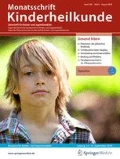Zusammenfassung
Vaskuläre Anomalien werden nach den Richtlinien der International Society for the Study of Vascular Anomalies (ISSVA) klassifiziert. Prinzipiell werden Gefäßtumoren von -malformationen unterschieden. Die Gefäßmalformationen werden nach den in den Läsionen vorliegenden Gefäßen eingeteilt: es werden kapillare, venöse, arterielle, lymphatische und gemischte Malformationen unterschieden. Oft weisen sie auf weitere Fehlbildungen und Syndrome hin. Neben Anamnese und körperlicher Untersuchung stehen Sonographie, MRT, MRT-Angiographie, klassische Katheterangiographie und Phlebographie für die Diagnose zur Verfügung. Zur Therapie werden Farbstofflaser, Embolisation, Sklerosierung sowie chirurgische Maßnahmen eingesetzt. Auch eine konservative Behandlung in Form von Kompressionswäsche, Lymphdränage und Physiotherapie ist möglich. Zur Diagnostik und Therapie ist ein Team von Spezialisten aus unterschiedlichsten Fachrichtungen erforderlich, wie es mit der Interdisziplinären Sprechstunde für „Hämangiome und vaskuläre Malformationen“ am Universitätsklinikum Freiburg seit 1994 realisiert wird. Das Team besteht aus Kinderchirurgen, Mund-, Kiefer- und Gesichtschirurgen, Plastischen Chirurgen, Gefäßchirurgen, Orthopäden, Radiologen, Neuroradiologen, Kinderkardiologen, Ophthalmologen, HNO-Ärzten, Dermatologen und Lymphologen. Die Pädiater spielen eine zentrale Rolle, da sie die Koordination übernehmen. Der Pädiater koordiniert auch die Langzeitbetreuung, die aufgrund der lebenslang bestehenden Veränderungen einen ausgebildeten und erfahrenen Betreuer notwendig macht.
Abstract
Vascular anomalies are classified according to the classification system of the International Society for the Study of Vascular Anomalies (ISSVA). Basically, vascular tumors have to be distinguished from vascular malformations. Vascular malformations can be capillary, venous, arterial, lymphatic and mixed. They are often associated with complex malformations and syndromes. As well as the history and the physical examination, such imaging methods as sonography, MRI, MRI-angiography and classic catheter angiography and phlebography are also available for diagnosis. Treatment involves pulsed dye laser therapy, embolization, sclerotherapy, and surgery. Conservative therapy with compression garments, lymph drainage and physiotherapy is also possible. Diagnosis and treatment of vascular malformations require an interdisciplinary team. This requirement has been realized in the vascular “hemangioma and vascular malformations” clinic at the University Hospital of Freiburg since 1994. The team is made up of pediatric surgeons, oral and maxillofacial surgeons, plastic surgeons, vascular surgeons, orthopedic surgeons, radiologists, neuroradiologists, pediatric cardiologists, ophthalmologists, otorhinolaryngologists, dermatologists, and lymphologists. The pediatricians have a central role as they are responsible for the coordination. The pediatrician also performs long term follow-up examinations. Because of the chronic nature of these life-long changes an experienced caretaker is necessary.






Literatur
Banieghbal B, Davies MR (2003) Guidelines for the successful treatment of lymphangioma with OK-432. Eur J Pediatr Surg 13:103–107
Burrows PE, Laor T, Paltiel H et al. (1998) Diagnostic imaging in the evaluation of vascular birthmarks. Dermatol Clin 16:455–488
Drolet BA, Esterly NB, Frieden IJ (1999) Hemangiomas in children. N Engl J Med 341:173–181
Dubois JM, Sebag GH, De Prost Y et al. (1991) Soft-tissue venous malformations in children: percutaneous sclerotherapy with Ethibloc. Radiology 180:195–198
Enjolras O, Mulliken JB (1997) Vascular tumors and vascular malformations (new issues). Adv Dermatol 13:375–423
Enjolras O, Riche MC, Merland JJ (1985) Facial port-wine stains and Sturge-Weber syndrome. Pediatrics 76:48–51
Földi E, Földi M, Weissleder H (1985) Conservative treatment of lymphoedema of the limbs. Angiology 36:171–180
Fujino A, Moriya Y, Morikawa Y et al. (2003) A role of cytokines in OK-432 injection therapy for cystic lymphangioma: an approach to the mechanism. J Pediatr Surg 38:1806–1809
Goldman MP, Fitzpatrick RE, Ruiz-Esparza J (1993) Treatment of port-wine stains (capillary malformation) with the flashlamp-pumped pulsed dye laser. J Pediatr 122:71–77
Gorham LW, Stout AP (1955) Massive osteolysis (acute spontaneous absorption of bone, phantom bone, disappearing bone); its relation to hemangiomatosis. J Bone Joint Surg Am 37:985–1004
Hein KD, Mulliken JB, Kozakewich HP et al. (2002) Venous malformations of skeletal muscle. Plast Reconstr Surg 110:1625–1635
Kennedy TL (1989) Cystic hygroma-lymphangioma: a rare and still unclear entity. Laryngoscope 99:1–10
Kern S, Niemeyer C, Darge K et al. (2000) Differentiation of vascular birthmarks by MR imaging. An investigation of hemangiomas, venous and lymphatic malformations. Acta Radiol 41:453–457
Kerst G, Niemeyer C, Hildebrandt F et al. (2001) Use of a myocutaneous flap after resection of a large lymphangioma. Eur J Pediatr Surg 11:139–141
Mulliken JB, Fishman SJ, Burrows PE (2000) Vascular anomalies. Curr Probl Surg 37:517–584
Mulliken JB, Glowacki J (1982) Classification of pediatric vascular lesions. Plast Reconstr Surg 70:120–121
Oranje AP (1986) Blue rubber bleb nevus syndrome. Pediatr Dermatol 3:304–310
Raab P, Wild A, Seller K et al. (2001) Correction of length discrepancies and angular deformities of the leg by Blount’s epiphyseal stapling. Eur J Pediatr 160:668–674
Rudolph R (1993) Familial multiple glomangiomas. Ann Plast Surg 30:183–185
Takahashi K, Mulliken JB, Kozakewich HP et al. (1994) Cellular markers that distinguish the phases of hemangioma during infancy and childhood. J Clin Invest 93:2357–2364
Horst CM van der, Koster PH, Borgie CA de et al. (1998) Effect of the timing of treatment of port-wine stains with the flash-lamp-pumped pulsed-dye laser. N Engl J Med 338:1028–1033
Wilting J, Papoutsi M, Christ B et al. (2002) The transcription factor Prox1 is a marker for lymphatic endothelial cells in normal and diseased human tissues. FASEB J 16:1271–1273
Yakes WF, Rossi P, Odink H (1996) How I do it. Arteriovenous malformation management. Cardiovasc Intervent Radiol 19:65–71
Ziyeh S, Schumacher M, Strecker R et al. (2003) Head and neck vascular malformations: time-resolved MR projection angiography. Neuroradiology 45:681–686
Ziyeh S, Spreer J, Rossler J et al. (2004) Parkes Weber or Klippel-Trenaunay syndrome? Non-invasive diagnosis with MR projection angiography. Eur Radiol 14:2025–2029
Danksagung
Wir danken allen an der interdisziplinären Sprechstunde „Hämangiome und vaskuläre Malformationen“ teilnehmenden Kolleginnen und Kollegen (http://www.ukl.uni-freiburg.de/kinderkl/vascular.html). Wir möchten auch den Kollegen der Johanniter-Kinderklinik St. Augustin und dem Zentrum für Kinderheilkunde der Universität Bonn danken, die mit uns gemeinsam die Patientin mit AVLM betreuten. Sie ist in der Zwischenzeit im Alter von acht Jahren leider verstorben.
Interessenkonflikt:
Keine Angaben
Author information
Authors and Affiliations
Corresponding author
Rights and permissions
About this article
Cite this article
Rössler, J., Salfeld, P. & Niemeyer, C.M. Diagnostik und Therapie von Gefäßfehlbildungen. Monatsschr Kinderheilkd 153, 364–372 (2005). https://doi.org/10.1007/s00112-005-1109-2
Issue Date:
DOI: https://doi.org/10.1007/s00112-005-1109-2
Schlüsselwörter
- Vaskuläre Anomalien
- Vaskuläre Tumoren
- Vaskuläre Malformationen
- Lymphangiome
- Interdisziplinäre Sprechstunde

